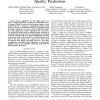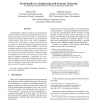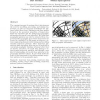686 search results - page 13 / 138 » Empirical Studies in Reverse Engineering |
CSMR
2010
IEEE
13 years 4 months ago
2010
IEEE
Legacy applications are still widely spread. If a need to change deployment or update its functionality arises, it becomes difficult to estimate the performance impact of such modi...
WCRE
2005
IEEE
14 years 3 months ago
2005
IEEE
Understanding a software system by just analyzing the structure of the system reveals only half of the picture, since the structure tells us only how the code is working but not w...
SAC
2004
ACM
14 years 3 months ago
2004
ACM
Web applications have become complex and crucial for many firms, especially when combined with areas such as CRM (Customer Relationship Management) and BPR (Business Process Reen...
ER
2007
Springer
14 years 4 months ago
2007
Springer
The constant increase of moving object data imposes the need for modeling, processing, and mining trajectories, in order to find and understand the patterns behind these data. Ex...
ICSE
2005
IEEE-ACM
14 years 10 months ago
2005
IEEE-ACM
End users develop more software than any other group of programmers, using software authoring devices such as e-mail filtering editors, by-demonstration macro builders, and spread...



